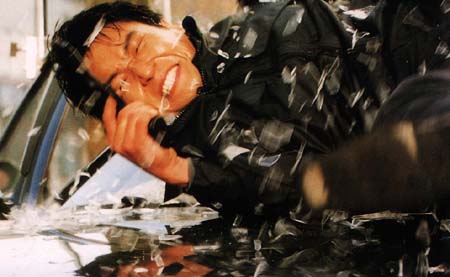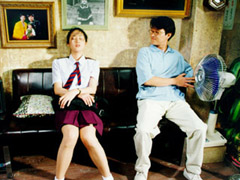Note: this is a slightly modified version of an article which first appeared in TAASA Review: The Journal of the Asian Arts Society of Australia (Volume 9, No. 1, March 2000). It was originally written to coincide with Nowhere to Hide's opening of the first Sydney Asia-Pacific Film Festival.
Genrebending in Contemporary Korean Cinema
By Darcy Paquet
Horror films with scarcely a drop of blood. Action films which digress into long, unmotivated detours. Comedies that end with the death of the hero. What is going on in contemporary Korean film?
Genre seems to define most Koreans' image of their film industry. Throughout Korea's film history, the melodrama has dominated popular film. In any given year, 50-70% of the films produced in Korea are classified (rather broadly) as melodramas. Popular movie stars are often best remembered for their roles in heartwrenching tragedies. The extent to which melodrama has become a part of Korea's self-image is illustrated in a scene from Park Kwang-soo's acclaimed 1990 feature Black Republic, when a barmaid makes a disparaging comment about a Hollywood action film on TV. Her companion replies, "It's better then some weepy melodrama," to which she retorts, "I like Korean movies!"
In an ironic way, melodrama seems to have influenced many Korean art films as well. The word 'realism' is often used in conjunction with arthouse films intended for intellectuals and the festival circuit. Both classic directors such as Yu Hyun-mok (Aimless Bullet, 1961) and contemporary figures such as Lee Chang-dong (Green Fish, 1997; Peppermint Candy, 2000) have been praised by domestic critics for their artful capturing of reality. The term 'reality', however, merits a closer look. After all, leaving a movie camera on a street corner for two hours would produce a highly realistic work, but not necessarily an interesting film. When critics use the word, they often imply the political orientation of the work - its portrayal of the neglected corners of society - or, in regard to form, the extent to which it rejects the conventions of the popular melodrama. In the melodrama, exaggerated feelings and circumstances work to arouse empathy in the viewer, whereas in most Korean art films, directors have filled their works with the mundane. In place of the throbbing, seductive music of the melodrama, we hear little to no music at all. The melodramatic hero's floods of emotion form a polar opposite to the bitter, silent hero of the art film. In this way, the genre of melodrama has had an indirect influence on many of the works that make up Korean film history.
 In recent years, however, Korean cinema has aimed to reinvent itself. The domestic film industry underwent a profound change after the 1997 Asian economic crisis, with the exit of the large business conglomerates that used to dominate the industry. Since then, venture capital has replaced the old conglomerates and a wave of fresh young filmmakers have begun to transform the industry. Audiences have responded in force, with interest in domestic films running at their highest level since the 1960s. In early 1999, the blockbuster Shiri smashed the domestic box-office record previously held by Titanic to become the most successful Korean film ever. Following on Shiri's heels came a string of box-office hits, giving Korean films a remarkable 36% share in total box-office receipts, one of the highest in the world for a predominantly local film industry.
In recent years, however, Korean cinema has aimed to reinvent itself. The domestic film industry underwent a profound change after the 1997 Asian economic crisis, with the exit of the large business conglomerates that used to dominate the industry. Since then, venture capital has replaced the old conglomerates and a wave of fresh young filmmakers have begun to transform the industry. Audiences have responded in force, with interest in domestic films running at their highest level since the 1960s. In early 1999, the blockbuster Shiri smashed the domestic box-office record previously held by Titanic to become the most successful Korean film ever. Following on Shiri's heels came a string of box-office hits, giving Korean films a remarkable 36% share in total box-office receipts, one of the highest in the world for a predominantly local film industry.
There are several ways in which the films of today have tried to distance themselves from their predecessors. Newer films tend to have a glossier feel to them, and as the technical capabilities of the industry have expanded, directors have started to employ sophisticated digital imagery and special effects. Many newer directors have been schooled in Korea's booming short film industry, and have thus brought some of the techniques and feel of short film to their feature debuts. However, one of the key ways in which filmmakers have tried to create a new image for the industry is in a blending and bending of old genres.
 Many of the major Korean hits in recent years have provided an interesting twist to their genre. Shiri (Kang Jae-gyu, 1999), for example, shrewdly combines the Hollywood action blockbuster with the Korean melodrama to result in a film which appeals to a wide spectrum of viewers. The Quiet Family (Kim Ji-woon, 1998) provides a funny and sick dissection of human nature in a fusion of the horror film and the comedy. This tale of a family-run lodge in the mountains is at turns playful and horrifying, and its enigmatic ending only further distances itself from the typical genre film. Christmas in August (Hur Jin-ho, 1998) is a melodrama in name but it rewrites the conventions of the genre by replacing emotional excess with understatement and encouraging its viewers to recognize death not as a tragedy but as a phenomenon which must be accepted with grace.
Many of the major Korean hits in recent years have provided an interesting twist to their genre. Shiri (Kang Jae-gyu, 1999), for example, shrewdly combines the Hollywood action blockbuster with the Korean melodrama to result in a film which appeals to a wide spectrum of viewers. The Quiet Family (Kim Ji-woon, 1998) provides a funny and sick dissection of human nature in a fusion of the horror film and the comedy. This tale of a family-run lodge in the mountains is at turns playful and horrifying, and its enigmatic ending only further distances itself from the typical genre film. Christmas in August (Hur Jin-ho, 1998) is a melodrama in name but it rewrites the conventions of the genre by replacing emotional excess with understatement and encouraging its viewers to recognize death not as a tragedy but as a phenomenon which must be accepted with grace.
I would like to focus on one recent film in particular that twists its genre in new and interesting ways. Nowhere to Hide (1999) is the sixth film by acclaimed director Lee Myung-se, who has developed both a reputation and a minor cult following in Korea for his creativity and unique style. Whereas many of his previous works have centered on issues of love and marriage (e.g. My Love, My Bride, 1990 and First Love, 1993), in his latest feature he takes a seeming change of course by choosing the action genre.
Action films typically feature a continuous level of high energy, stunts, chase scenes, fights, escapes, rescues, non-stop motion, an unbroken storyline, and a resourceful hero struggling against incredible odds to defeat an evil villain. Many aspects of Nowhere to Hide fit this description: it centers on a group of detectives who struggle to catch a wanted assassin; the film features chase scenes (one in which the detective is barefoot), fights (often notable for their striking visuals and humor), disguises, killings, and narrow escapes. Nonetheless some of Lee's objectives in making the film cause him to adapt the genre to suit his own needs.
 One of Lee's ambitions in Nowhere to Hide is to portray the work of detectives in a less romanticized light. As such he incorporates many of the menial, day-to-day tasks faced by our heroes, either in the office or on a stakeout waiting for a suspect. In terms of pacing, this causes disruptions in the non-stop motion expected of an action film. However, Lee's skillful handling of the camera, lighting, set, and dialogue in these scenes provide for a kind of 'cinematic action' to fill in the gaps.
One of Lee's ambitions in Nowhere to Hide is to portray the work of detectives in a less romanticized light. As such he incorporates many of the menial, day-to-day tasks faced by our heroes, either in the office or on a stakeout waiting for a suspect. In terms of pacing, this causes disruptions in the non-stop motion expected of an action film. However, Lee's skillful handling of the camera, lighting, set, and dialogue in these scenes provide for a kind of 'cinematic action' to fill in the gaps.
In one scene a pair of detectives dream of eating as they sit in their car on a stakeout. As they speak, an image of the food appears above their head as hot pepper, green onion and kimchi are piled on in turn. In other scenes the characters are upstaged by the weather, which shifts almost magically between snow, bright sunshine and driving rain. In one tense scene we cut to a small bead of sweat on our hero's nose as it rolls off and falls onto his bare feet. These and other such elements usurp the traditional status of action within the action film, allowing for viewers to focus their attention on the more cinematic aspects of the work.
Lee's second concern in this film is somewhat more abstract. He notes, "In a Monet painting, the theme is not the water lily. The water lily is just the object to paint light upon. As it floats, we see its reflection on the water, and that is what we call painterly. My intention is the same. In this film, I wanted to show the filmic. The story and the characters are not the main focus of my film. Movement is. Movement enters the other elements in this film to create kinetic action." [excerpted from the film's press kit]
Lee claims that he analyzed the movements in dance and World Cup soccer before shooting the film. This approach to a film also results in a de-emphasis of plot. Although action movies typically incorporate a constant stream of events, in Nowhere to Hide, Lee's focus on movement often grinds the story to a halt. In directing our attention to the abstract forms of the characters' actions, the traditional narrative elements of the action film receive less of our attention.
In many ways this film can be considered an action-art film; a work that adopts the superficial forms of an action film, but then utilizes them for completely different aims. Upon its release in theaters it was rightly recognized as a completely new kind of movie. Despite the film's artistic focus and its de-emphasized narrative, Nowhere to Hide became a huge hit in Korea, outperforming such Hollywood giants as Austin Powers, Notting Hill and Wild Wild West. In its boldness and its creativity it set itself apart from the genre films of Korea's past and identified itself as a part of Korea's new film reformation.
Korean filmmakers' experimentation with genre is likely to continue into the future, as a new generation takes control of the industry and attempts to shape its own identity. With an audience so supportive of this brand of experimentation, one can only imagine what lays before us.